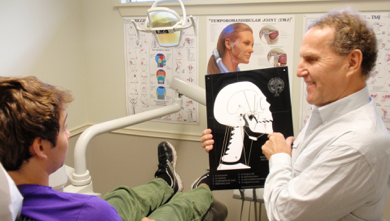TMJ Disorder

The focus of our practice is on treating TMJ (temporomandibular joint) disorders. Did you know that many chronic headache, ear, neck and back problems are actually caused by TMJ syndrome? TMJ syndrome results from the malocclusion of the teeth or jaws. We offer non-surgical treatment that is often covered by medical or dental insurance programs, depending on the individual plan. Please call our office for a consultation if you suffer from any of these symptoms -
-
•headache
-
•dizziness
-
•jaw pain
-
•facial pain
-
•earaches
-
•eye pain
-
•migraines
-
•vertigo
-
•Meniere's disease
-
•ringing in the ears
TMJ Disorder
Until recently, many symptoms such as headaches, nausea, dizziness, earaches, conductive hearing loss, sinus problems, face, head, eye, ear, neck, shoulder, and back pain have sometimes been misdiagnosed. It is now known that Temporomandibular Joint (TMJ) disorder accounts for a large number of these previously uncured and painful ailments. These types of pain are in fact symptoms of the syndrome, and correcting the problem rather than the symptoms is at the heart of the TMJ treatment.
Malocclusion and the TMJ
Your jaw joint, or TMJ, holds your lower jaw in place and is suspended beneath your skull by an intricate, complex system of muscles and tendons. The way your teeth fit together, called occlusion, your TM joint, and surrounding muscles are closely interrelated and affect each other during your everyday activities such as speaking, chewing, and swallowing. When your teeth do not fit together properly, in a condition known as malocclusion, the jaw automatically shifts to a new position to compensate for the malocclusion, causing stress in and around the jaw joint and muscles. Symptoms of malocclusion may be clenching, grinding, sensitive teeth, fractured teeth, premature tooth wear, and stress on the muscles and tendons, some of which may occur during sleep. The jaw’s attempt at compensation often triggers compensation in the position of the head, neck, shoulders, and back, resulting in headaches, muscular aches, pain in the face, neck, shoulders and back, dizziness, nausea, earaches, ringing in the ears, loss of hearing, and many other symptoms.
There is a neurological aspect to the disorder, as well, because nerves and blood vessels, which pass through a tiny opening in the bone, can be compressed, resulting in a cascade of symptoms, which can include seizures, tremors, tics, and movement disorders. Brendan Stack, DDS, MS, of Vienna, Virginia, has fascinating videos of TMJ patients with movement disorders on his website, tmjstack.com.
Diagnosing the Problem
Before prescribing the proper treatment for your particular problem, a variety of diagnostic procedures are necessary. X-rays will be taken of your head, teeth and jaw joint to provide a clear picture of your own TMJ anatomy and the position of various structures within the jaw joint. In order to study the relationship of the patient's teeth and joints, diagnostic models are cast and analyzed, along with photographs, and precise measurements are taken to determine the position of your temporomandibular joint and help determine the proper treatment. A thorough physical exam is also necessary, utilizing kinesiological testing, muscle testing, and range of motion measurements.
A link with Parkinson’s Disease?
Recent research shows that there might be some connection with TMD and Parkinson’s Disease. Many patients with movement disorders, tremors, and seizures have shown improvement after TMJ treatment. For more information, please read the following articles:
Parkinson’s Newsletter- issue 218.pdf
Parkinsons Newsletter- issue 219.pdf
Parkinsons Newsletter- issue 223.pdf
TMJ Treatment
TMJ treatment is both orthopedic and neuromuscular in nature and consists of orthopedic, physiotherapeutic and sometimes pharmacologic treatment modalities. Treatment is directed towards orthopedic realignment of the mandible (the lower jaw) to the skull, stabilizing the left and right temporomandibular joints. This readjustment restores the jaw to normal physiological function, and relaxes chronically contracted (spastic) craniofacial and cervical muscles. We also believe in working in concert with your physician, general dentist, orthodontist, chiropractor, physical therapist or massage therapist to obtain the best results for you.
Early Treatment is Important
The importance of early treatment cannot be overstated. TMJ problems can advance in stages and grow progressively worse. Thus, a minor problem now could become a major source of pain in the future. Additionally, chances of successful treatment increase substantially the earlier treatment is accomplished.
If you are interested in receiving TMJ treatment, please call our office to set up an appointment.
------------------------------------------------------------------------------------------------------------
TMJ is not a new thing! There is substantial literature on it going back 70 years. One of the most fascinating and insightful books is the textbook, “The Dental Physician”, by A.C. Fonder, 1977, Medical Dental Arts. For more information on TMJ Disorder and its treatment, please check out these other books on TMJ that Dr. Hurme recommends:
Your Jaws Your Life, by David C. Page, D.D.S. Smile Page Publishing.
This is available directly from the publisher:
SmilePage Publishing
P.O. Box 20300
Baltimore, MD 21284
Phone (410) 296-7224, Fax (888) 865-JAWS
Web www.SmilePage.com
Killing Pain Without Prescription, by Harold Gelb, D.M.D. Harper & Row Publishers.
Taking Control of TMJ, by Robert O. Uppgaard, D.D.S. Publishers Group West.
These are available from:
EOP, Inc.
801 Transfer Road
St. Paul, MN 55114
(800) 328-8021
The Trigger Point Therapy Workbook, by Clair Davies, NCTMB, New Harbinger Publications

TemporoMandibular Joint Disorder


